The Home Heating Jargon Buster
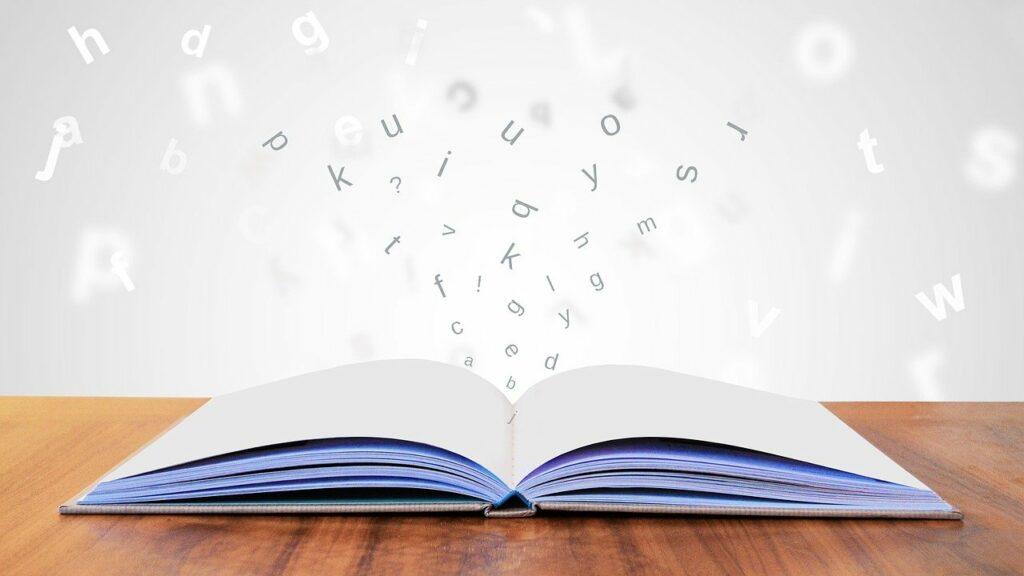
Let's face it, the world of home heating is full of complicated jargon.
To help you cut through the confusion, we've put together a jargon buster so the next time you have heating problems there's one less thing to worry about.
Types of boiler
There's more than one type of boiler and it's good to know the differences so that you can choose the right one for your home.
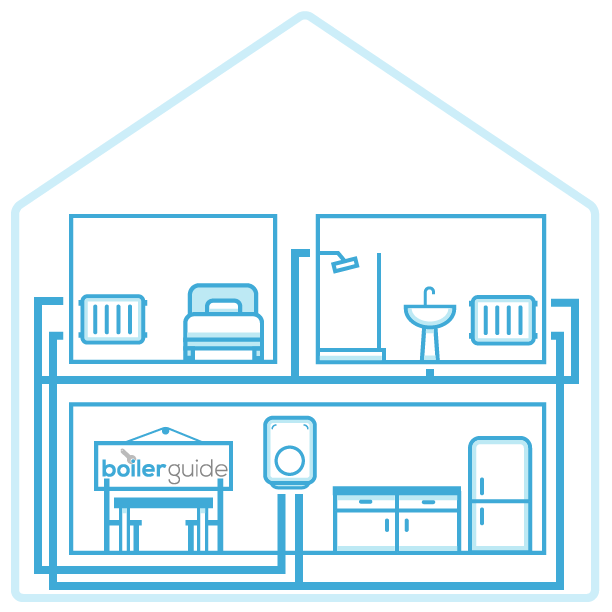
How a combi boiler works
Combination (combi): A combi boiler is a central heating and hot water system in one unit. It differs from other boilers, as it doesn't require any external parts. They are only recommended for homes with one bathroom though, as their hot water supply is limited.
System: System boilers are used in homes with multiple bathrooms. They have an external hot water storage cylinder to provide a larger supply to bigger homes.
Regular: Regular boilers (also known as conventional) are a traditional heating system which includes external elements – a water feed tank (also known as a cistern) and a hot water cylinder. They take up a lot of space in a home and are now only recommended if the need is to replace an existing regular boiler.
Back boiler: Large boilers fitted behind a fireplace that were installed in the 1960s, 70s and 80s. Back boilers are no longer being made and if you have one then you should get it replaced.
Condensing: All modern boilers must be condensing by law. This term describes an internal function, rather than a type or model of boiler. Condensing boilers recycle heat that would otherwise escape from the flue pipe
(see 'What's in the boiler' below). This means they are much better for the environment and use less fuel.
Non-condensing: In boilers which are non-condensing, heat can escape through the flue pipe. They are inefficient and bad for the environment. They are replaced with condensing boilers so that this lost heat can be recycled back into the heating system. It is still possible to install a non-condensing boiler but only in rare circumstances.
Room-sealed: Older boilers used to take in air from the room where they were fitted for ventilation. Modern boilers don't do this, instead they have a balanced flue pipe which allows outside air to travel into the boiler to keep it ventilated and also expel any waste. This internal ventilation is what indicates that a boiler is 'room-sealed'. Any boiler fitted in a bedroom must be room-sealed.
Fuel types
There are a number of fuels that boilers can run on. The most common is natural gas, but properties that aren't connected to the gas network will need to use an alternative.
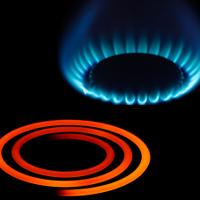
Gas and electric
Gas: Most boilers across the UK run on natural gas. It's supplied directly to homes via the gas network and then burned by the boiler. Click here to compare gas boilers.
Oil: The most popular option for homes that aren't connected to the gas network is oil. The oil is stored in a tank at the property and is connected to the boiler. Compare oil boilers here.
Liquified Petroleum Gas (LPG): This is a fuel that can be stored in canisters. Many of the best gas boilers can be converted to run on LPG. Explore the differences between Oil and LPG.
Electric: Rather than burning a fuel, electric boilers turn electricity into heat. They're very efficient as all of the electricity can be turned into heat. The downsides are that electricity is the most expensive fuel and electric boilers can only meet the heating demands of smaller homes. Click to compare electric boilers.
Biomass: This is a term which refers to biological materials, such as wood, which can be used as a fuel source. Specialist biomass boilers can burn these materials to heat the home and hot water. It is considered to be a renewable energy source, however, there are still questions being asked as to whether this is true.
What's in the boiler?
If your boiler starts playing up, it can be handy to know the names of some of its parts and what they do.
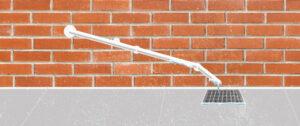
Condensate pipe
Condensate pipe: When a condensing boiler recycles heat from waste gases, it produces condensation. This liquid is sent down the condensate pipe and directed away from the property to an external drain.
Sometimes this pipe can freeze during the winter – find out how to thaw a frozen pipe.
Fan: This is used to push out harmful gases through the boiler’s flue pipe. As fuel is burnt in the boiler, harmful gases are released and it is crucial to have a fan to redirect those gases out of the boiler and away from your home.

Flue pipe
Flue pipe: Waste gases from burning fuel are emitted out into the atmosphere through the flue pipe. These pipes need to be fitted in a safe location inline with the Boiler Flue Regulations.
Heat exchanger: This is a device inside of the boiler which allows the heat from burning gas to be transferred, through the surface of internal pipes, to the water supply. This creates the hot water which is then directed around the heating system. The heat exchanger is a crucial part of the boiler.
Pilot light: Older boilers had a permanent flame known as the pilot light. It would always be burning through a small supply of gas and would light the gas when you need heating or hot water. Modern boilers don't have pilot lights so you don't need to worry about them. These have been replaced by electronic ignitions.
Learn more about how a boiler works inside.
Primary Circuit Board (PCB): This is the 'brain' of the boiler. It controls all of the electrical parts of the boiler such as the fan and digital display. If something goes wrong with it the boiler won't work.
Outside the boiler
Central heating systems are made up of far more than just a boiler and radiators, and sometimes it's the external parts that can cause problems.
Feed (cistern) and expansion tank: Fitted in the loft, the feed (aka cistern) tank fills with cold water from the mains which is fed to the boiler. A smaller, second tank may also be fitted, this is an expansion (or header) tank. This is there to fill the heating system and provide extra space for water to expand when heated.
These tanks are only used as part of a heating system which includes a regular boiler.
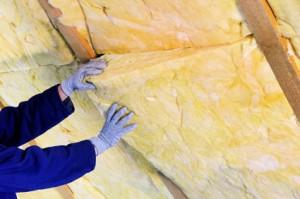
Insulation in a loft
Insulation: A material (that often looks like a thick fluffy rug) used to prevent heat escaping from the home through the walls, roof or floor. Increasing the level of insulation in your home will increase efficiency and help to lower your heating bills.
Insulation is particularly important if you're installing a heat pump as they heat water to a lower temperature than boilers.
Magnetic filter: Catches any debris (rust, limescale and sludge) from the heating system before it has a chance to build-up. It will usually sit within the piping to filter the flowing water before it enters the rest of the system.
A build-up of debris could block the hot water from flowing around the radiators. Most heating engineers recommend fitting a magnetic filter as part of any new boiler installation.
While we're on the subject, water treatment is also an important part of keeping your heating system healthy.
Smart thermostat: A remote device which controls your central heating. You can use a smart thermostat with an app or smart device. They are made to give you better control and help cut down bills by allowing you to monitor your usage more closely.
Leading smart thermostats include Nest and Hive – compare them here.
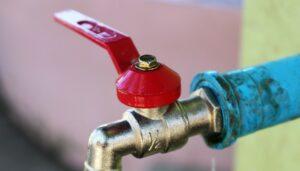
Stopcocks come in different styles
Stopcock: This is a tap or lever used to control the flow of water into your property. An external stopcock controls water into your street or block, an internal stopcock is located in your property and can switch your water on or off.
They are usually found under a sink, but it's important to know where yours is in case of an emergency.
Unvented cylinder: A hot water cylinder that has a direct connection to the mains water supply. You will need an unvented cylinder if you have a system boiler.
Vented cylinder: These hot water cylinders are fed from a cold water tank in the loft.
Any heating system with a regular boiler will need a vented cylinder.
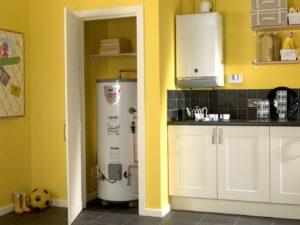
A system boiler works alongside an unvented cylinder
Boiler specifications
When considering boilers, there are a few key terms you will need to look out for so you can find the best one to suit your needs.
Capacity (in terms of cylinders): How much water the cylinder is able to store (measured in litres). Homes with more bathrooms will need a cylinder with a larger capacity.
Efficiency: Refers to how well the boiler turns fuel into heat for your home and hot water. Efficiency is rated as a percentage. For example, condensing boilers tend to have an efficiency rating of at least 92%. This means that for every £1 spent heating your home, only 8p worth of heat is lost out of the flue pipe, which makes them incredibly efficient. These ratings can determine how likely you are to save money on your energy supply.
Flow rate: Shows how much hot water will come out of the tap each minute. Measured in litres per minute (l/min). The combi is the only boiler with a flow rate, as system and regular boilers store hot water in a cylinder.
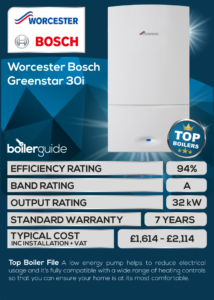
Example of boiler specifications
Kilowatt (kW):A measurement of a boiler's power. You'll see this when looking at the output rating.
Kilowatt-hour (kWh): This shows how much energy your boiler is using per hour and can be found listed on your energy bills. As an example, a 24 kW boiler will need 24 kWh of energy each hour.
Output rating (size): This is a measurement of the boiler’s power - otherwise known as the size of the boiler (which has nothing to do with the dimensions). It’s measured in kilowatts (kW) and must match the heating demands of your home. For example, a large home with lots of radiators will need a boiler with a higher output rating, as it will need more power. We answer all the questions on boiler sizes in our ‘what kW boiler do I need?’ guide.
Quote: Before going ahead with a new boiler installation, you should get an estimated price for the work from a qualified professional. This is known as a quote. Getting quotes from at least 3 heating engineers will make sure you get the most competitive price from the best person for the job. You can get free quotes right here.
Warranty: The manufacturer of your new boiler will see that you're covered in the event of an issue. Warranty periods tend to range from 1-10 years, but some go beyond this. A boiler with a long warranty is likely to be far more reliable than a boiler with a 1 year warranty, for example.
Boiler problems and getting help
Every now and then our boilers can run into trouble. It can be hard enough finding the cause of the problem but the name of the solutions to fix them can often be confusing too.
Whilst you can tackle some small heating issues yourself, such as bleeding radiators or increasing boiler pressure, if you're in any doubt you should always contact a qualified heating engineer.
Airlock: This is when trapped air blocks the hot water from getting to the hot water taps or central heating system. There are 2 ways to clear an airlock and we cover them both in this
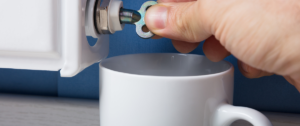
Bleeding a radiator
Bleed/Bleeding radiators: The process of freeing trapped air from the heating system. You might not think so, but too much air in the heating system can cause a problem. Mainly blocking hot water from getting round the radiators.
If your radiators aren't heating up properly then they may need bleeding. Take a look at this step-by-step guide to bleeding radiators.
Balance radiators: This makes sure that all of the radiators around your home are heating up evenly. Our guide to balancing radiators will take you through the process step-by-step.
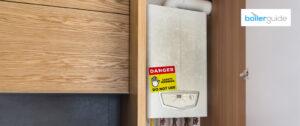
Condemned Boiler
Condemned boiler: A boiler that has been labelled unsafe by a professional heating engineer. They will stick a 'Danger Do Not Use' sticker to the boiler and you should seek to get it replaced as soon as possible.
If your boiler has been condemned, here's what to do next.
Gas Safe: A gas boiler service, repair or replacement must be carried out by a Gas Safe registered heating engineer. They're the only people qualified to work on gas appliances.
You can check if a heating engineer is Gas Safe by looking them up on the Gas Safe Register. We also recommend asking to see their Gas Safe ID card before they get to work. This card lists the gas appliances they're permitted to work on and also has an expiry date.
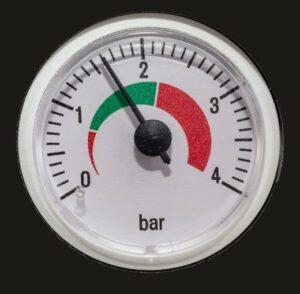
Boiler pressure gauge
Increase boiler pressure: Boiler pressure should sit between 1 and 2 bar (always check the manufacturer's instructions though). Your system has low pressure if it drops below 1 bar and needs to be increased. You can take a pressure reading by looking at the pressure gauge on the boiler.
Powerflush: Chemicals are flushed through the heating system to clear out any rust, limescale and debris. Your heating engineer should perform a powerflush when replacing your boiler.
Renewables
Home heating is one of the biggest emitters of carbon into the atmosphere. As a result, renewable heating systems (that don't emit carbon) are growing in popularity.
Clean Heat Grant: A scheme being introduced to replace the RHI from April 2022. It will help homeowners cover the upfront costs of installing a renewable heating system (which are known for being higher than traditional boilers).
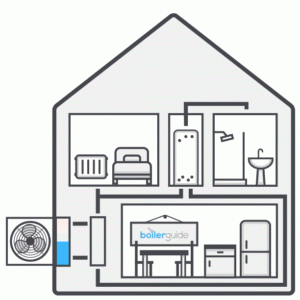
How an air source heat pump works
Heat pump: Heat pumps take heat from renewable energy sources such as the air (air source heat pumps) and ground (ground source heat pumps).
There are also water source heat pumps, but you can only consider one of those if you live close to a river or body of water.
Low-carbon: Heating systems that emit no or little carbon into the atmosphere. These are mainly renewable heating systems such as heat pumps.
Renewable: Energy sources that will never run dry – the opposite of fossil fuels. Renewable energy sources include the air, wind and sun (solar). Also known as sustainable energy sources.
Renewable Heat Incentive: As a reward for heating your home with renewables, you could be entitled to government payments. This scheme is due to end in March 2022. Apply before then for the chance to receive payments for 7 years. Known as the RHI for short.
Solar thermal: Panels that absorb heat from the sun to warm the water stored in a cylinder. Fitting a solar water heating system could give your home free hot water!
Solar PV: Panels that turn solar energy into electricity that can be used to power the electrical appliances in your home. PV stands for photovoltaic.
Acronyms
ASHP/GSHP – Air Source Heat Pump / Ground Source Heat Pump
CH – Central Heating
CoP – Coefficient of Performance:
This is an efficiency rating for heat pumps. The higher the CoP, the more energy efficient it is. For example, a CoP of 4 means that for every 1kwh of electricity used, 4kwh of heat is produced.
DHW – Domestic Hot Water:
Water which comes from a hot tap or cylinder.
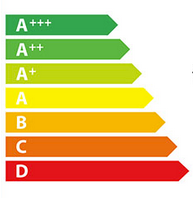
ERP rating scale
ErP – Energy-related Products Directive:
A directive introduced by the EU in 2015 to reduce carbon emissions. It included new criteria for manufacturers to produce more energy efficient products and a new labelling system to classify product efficiency. This updated the way we classify boiler efficiency. Learn more here.
l/min – Litres per minute:
The measurement of flow rate for combi boilers.
MCS – Microgeneration Certification Scheme:
The MCS certifies, quality assures and provides consumer protection for installations and installers of small scale renewable technologies (such as solar PV, biomass, wind and heat pumps).
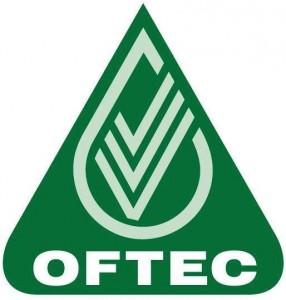
Oil Firing Technical Association
OFTEC – Oil Firing Technical Association:
A competent person scheme, with a register of technicians who install and maintain oil, solid fuel and renewable heating equipment. Learn more about OFTEC.
SCoP / SPF – Seasonal Coefficient of Performance / Seasonal Performance Factor:
A rating given to heat pumps based on how they will perform in different temperatures. It is used for both ground and air source heat pumps and can help you make comparisons based on your location and home heating needs.
SEDBUK – Seasonal Efficiency of a Domestic Boiler in the UK:
An old efficiency rating system for boilers. It was replaced in 2015 with the new ErP system.
TRVs – Thermostatic Radiator Valves:
Enable you to set a temperature on individual radiators and shut off the flow of water when your desired temperature is reached. These are considered 'smarter' than manual valves, but not as advanced as wifi enabled valves. Learn more about different radiator valves.



